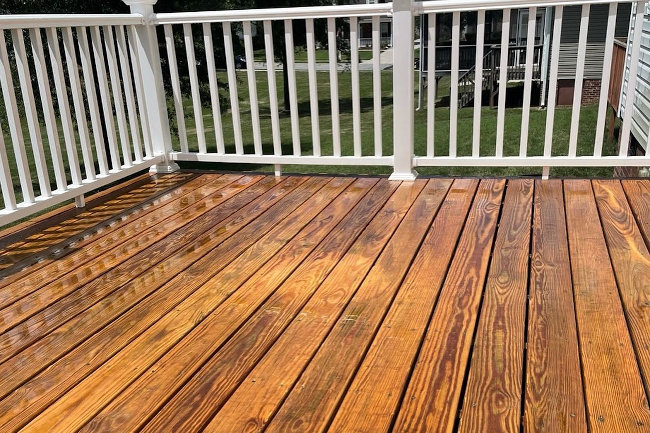Stain Deck for a Resilient Finish: Tips and Techniques
Stain Deck for a Resilient Finish: Tips and Techniques
Blog Article
A Comprehensive Guide to Different Sorts Of Deck Staining Techniques for Ultimate Protection and Appearances
In the realm of deck upkeep, the art of discoloring stands as a critical action in the direction of both preserving the honesty of your exterior space and boosting its visual allure. As we browse with the intricate globe of deck staining techniques, one starts to appreciate the nuanced approaches that can make all the distinction between a sub-par surface and a flawless one.
Recognizing Different Kinds of Spots
Various kinds of stains are frequently used in the procedure of deck discoloration to attain different visual and protective impacts. Clear spots are suitable for showcasing the all-natural grain of the wood while supplying minimal security against UV rays and wetness. On the various other hand, semi-transparent spots offer an equilibrium between color improvement and protection, enabling some wood grain to reveal through. For a much more nontransparent finish that gives maximum security versus the elements, solid discolorations are the preferred option. These discolorations can be found in a wide variety of colors and successfully hide the wood grain.
Toners include a tip of color to the wood while offering very little protection, making them suitable for newer decks with less wear. Understanding the characteristics and advantages of each kind of discolor is important for accomplishing the wanted look and durability for your deck.
Choosing the Right Discoloration Shade
When thinking about the appearances of your deck discoloration task, the choice of stain shade plays a critical function in enhancing the safety high qualities of the chosen stain kind (Chicago Deck Staining). The shade you choose can significantly influence the total appearance of your deck, as well as its capacity to stand up to the elements with time
When choosing a stain shade, it's vital to think about the existing shade plan of your home's exterior. Integrating the deck discolor with the overall visual of your home can create a aesthetically enticing and cohesive exterior area. In addition, the color of your deck tarnish can influence the temperature level of the deck surface; darker shades tend to soak up more warm, while lighter shades reflect sunshine and remain cooler.
Additionally, the sort of timber you are discoloring will certainly also influence just how the stain color appears. Different timber types can interact with the tarnish in various methods, potentially modifying the last color. It's advisable to evaluate the tarnish on a small, unnoticeable area of the deck to make certain the color turns out as wanted prior look what i found to proceeding with the entire task.
Preparing Your Deck for Discoloration
To make sure a resilient and successful deck staining project, extensive prep work of the deck surface area is crucial. Begin by cleansing the deck extensively to remove dirt, grime, mold, and any kind of old tarnish or end up.
Examine the deck for any damaged or rotten boards that require to be changed. Hammer down any kind of sticking out nails and sand any type of rough areas to make certain a smooth surface area for staining. Check for any loosened barriers or steps that might require tightening up or repair.
When the deck is clean, completely dry, and in good repair, consider using a wood brightener to recover the deck's natural shade and open up the timber pores for better stain infiltration. Finally, shield any neighboring plants, furniture, or surfaces with plastic bed linen prior to waging the discoloration procedure. Appropriate prep work is essential to achieving a professional-looking surface and optimizing the durability of your deck discolor.
Using Discoloration With Various Strategies
For a specialist and flawless surface, the approach of using discolor plays a crucial function in boosting the appearance and toughness of your deck. There are numerous techniques you can utilize to make certain an effective application of discolor.
It is ideal for intricate areas and reaching in between deck boards. Back-brushing after rolling is advised to even out the discolor and work it into the wood for better penetration.
Splashing is another preferred method, offering rate and convenience of application, particularly for huge deck areas. Whichever technique you pick, making sure proper preparation and adhering to producer standards will aid accomplish a gorgeous and durable stain surface on your deck.

Maintaining and Re-staining Your Deck
When it comes to re-staining your deck, the regularity depends on different factors such as the kind of stain made use of, the climate in your location, and exactly a fantastic read how much wear and tear your deck experiences. Usually, it is suggested to re-stain your deck every 2-4 years to maintain its security and visual appeals.
Before re-staining, make sure the deck is tidy, completely dry, and free of any previous discolor residue. Select a high-grade stain that matches your deck's product and gives the wanted level of protection.
Conclusion
In conclusion, understanding the various sorts of deck spots, choosing the appropriate color, properly preparing the deck, using tarnish with numerous strategies, and re-staining the deck and keeping are important actions for ultimate protection and looks. By adhering to these steps, you can guarantee that your deck remains in leading condition for his comment is here years to come.
Additionally, the color of your deck tarnish can affect the temperature of the deck surface; darker shades often tend to take in more heat, while lighter shades show sunlight and stay cooler.
It's suggested to check the tarnish on a little, inconspicuous location of the deck to make sure the color turns out as wanted prior to continuing with the entire project.

Report this page